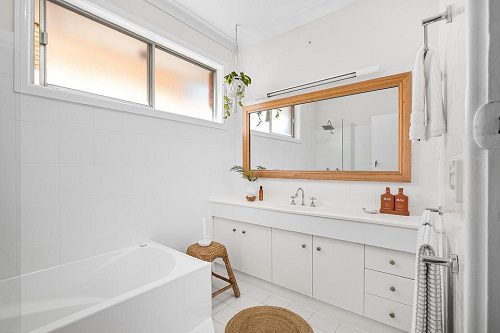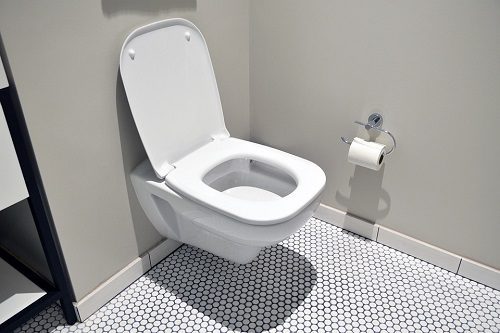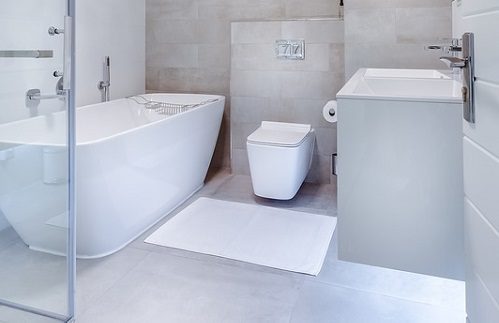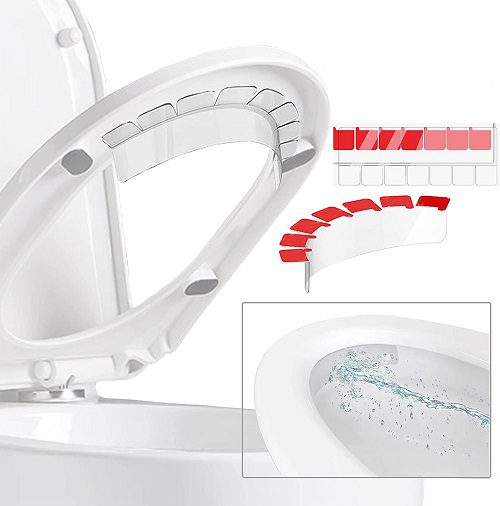It’s very important to protect your bathroom floor as it functions as a barrier that keeps stains, bacteria, and other germs from getting into the toilet, making it unhygienic. So, protecting the floor of your bathroom from urine and other stains is very critical in ensuring that your toilet is germ-free and safe for all users. This guide highlights tips on how to protect bathroom floor from urine using toilet base plates, mats, toilet floor protectors, and regular cleaning.
How to Stop Peeing Under The Toilet
It is annoying to find pee under the toilet seat when you are about to use it. Most men will be victims of pee splashes sometime in their lives. There are two major reasons why pee splashes on the side of the toilet seat – your distance from the urinal bowl and your angle of aiming when you pee.
Urinating while standing prolongs the distance the pee travels before reaching the toilet bowl, which causes the pee to travel at a higher velocity, resulting in a bigger splash. It is important to learn how to properly use the toilet when peeing for the sake of the people in your house. Pee stains make the bathrooms smell disgusting and very unpleasant. When you learn where to aim the toilet bowl properly, you will be able to easily use the toilet without having your pee splash under the toilet seat.
It is more likely that if you aim at a urinal or bowl at an angle of 90 degrees or closer, the pee will splash under the toilet seat. Therefore, aim for a sloping angle for a better result. And if you have a child who is doing potty training, it is also possible that pee will splash under your toilet seat. It takes time for a child to master the skill of aiming at the toilet bowl while standing, and there will be accidents before your child is old enough to understand it. Help your child practice peeing while standing on an outside urinal or potty to help him avoid putting a mess in your indoor toilets.
As an adult, you should try to hit the wall of the toilet bowl at a gradual angle. It is best to slowly get a small stream of urine into the bowl at an angle you can control (45 degrees). In other words, aim to get it into the bowl with a slight angle, preferably around 45 degrees, and avoid angles of more than 90 degrees. Peeing directly into the water also causes a huge cavity, creating a massive splash back when the water begins to collapse on itself.
Alternatively, lay toilet paper in your bowl before you start peeing. Place a couple of pieces of tissue paper in the toilet bowl to absorb the impact of the urine stream, and avoid any potential splashback. Some obstructions such as toilet paper or urinal covers, splash guards, or urinal inserts can help too.
It would be best if you always stood closer to the toilet bowl. Always pee while sitting, and avoid shaking too briskly when you’re done. Did you know that peeing while sitting is very relaxing? You should try it!
In addition, you should avoid holding urine for too long by going to the toilet frequently. It’s easier to experience splashbacks when the pressure is too high. If it’s a medical condition, consider seeking help from a medical practitioner.
How Does Pee Get Around The Toilet?
If you have ever wondered why there is pee around the toilet bowl, you are not alone. It is a very common question that many plumbers get asked every time they visit their clients. Apparently, each time you flush the toilet, all the water in the toilet bowl is forced down the drain. When that happens, a vacuum is formed within the tank. The water in your bowl is then pulled up the drain by the vacuum, and then it drains into the bowl.
When you see urine near the base of your toilet, it could be a serious problem that needs a quick fix. It may be that water from your toilet tank is leaking out of the pipe into your toilet, which may cause a small puddle to form. Or, it could be that there is a hairline crack in the base of your toilet. You should also check if it appears after you flush the toilet or if it appears before you visit it. This will help you decide whether you have a major or minor issue.
Below are some other causes of urine appearing around a toilet bowl or bathroom floor:
1. Backsplashes
Maybe the people who use the toilet are not as careful as you would want them to be! For men, failure to aim inside the toilet bowl when urinating can lead to having a lot of urine around the base of the toilet. The same can happen when ladies sit at a particular angle while urinating, which may cause backsplashes depending on how the urine hits the bowl surface. Urinating at a sharp angle and with high pressure will definitely cause urine to leak to the base of the toilet.
2. Loose Toilet Tee Bolts
The leaks could be due to loose tee bolts. These are located on both sides of the toilet base and are usually covered with a rubber or plastic cover that matches the bowl. You can tighten these bolts back using an adjustable wrench to tighten them. This will seal the toilet flush to the drainpipe and stop it from leaking.
Once you’re done, flush the toilet to test it. You will need to change the toilet’s wax ring if the leak is still there. If that is the case, apply some caulking around the toilet’s base where it touches the bathroom floor.
3. Worn Out Wax Ring
If you see urine in your bathroom or around the toilet, it may mean that the wax ring on the bottom of the toilet is worn out, and if you flush the toilet, it leaks out at the base of the toilet. To repair this, you will need to either replace the wax ring with a new one or use rubber to seal the toilet bowl, which will be less messy.
You will need to empty the bowl, remove all the tee bolts, and lift the toilet off the flange. You then just remove the old wax ring, replace it with a brand new one, and put the toilet unit back in place. Some of these bathroom floor issues may be easy to fix yourself. However, others may require some expertise, and you may need to call in a plumber to repair them.
How to Keep The Bathroom Floor Clean
Here are some great ways to keep your bathroom floor clean and free of smelly urine:
1. Ventilate
Keeping your bathroom properly ventilated is one of the most important things that you can do to keep it dry. If you don’t have proper ventilation in your bathroom, the water from showers may remain inside the bathroom and cause you to feel damp or experience a musty smell. It’s very important that you have a good ventilation fan installed in the space.

2. Proper Cleaning Products
Using the right cleaning products is important to keep the bathroom dry and clean. Avoid using cheap products as they will make your bathroom look dirty and discolor the floor. Buy the best cleaning tools like steam mops or grout cleaners to make your bathroom look neat.
Sometimes, it becomes really difficult to get rid of all the hair and other debris on your bathroom floor. Using a vacuum cleaner is the best solution to help you get rid of those things. You should perform this task at least once a week.
3. Shower Enclosure
Installing high-quality shower enclosures can help you separate the wet from the dry areas of your bathroom. Shower enclosures are usually installed around the shower area and are typically supported by a series of railings or curtain rods attached to the ceiling. Install a nice shower enclosure for your bathroom to stay dry and clean even after a bath.
4. Water-Resistance Tiles
Having proper tiles in your bathroom will help you minimize the risk of people falling or slipping. The elderly and kids can easily move around the bathroom easily. Dry bathrooms are common in modern households, and most western countries have adopted this trend. Many people still put buckets in the corners of their bathrooms just to make them look neat. Many homeowners now prefer a dry bathroom to prevent accidents and keep the bathroom germ-free.

What Do You Put On Floor Around Toilet?
You may also need to place certain things on the bathroom floor around the toilet to protect it from damage and urine penetration. They include:
1. Use a Toilet Floor Mat
Using a few toilet floor mats in your bathroom is a good idea. While potty training young children on how to properly use the toilet every time they visit the bathroom, it’s essential to use these mats to prevent urine spills that will eventually stain the floor. The mats are great for protecting areas where wear and tear are common.
Floor mats are great for terrazzo, tile, marble, wood floors, and granite. They perfectly prevent slipping and protect the floor from damage. Furthermore, the mats can easily prevent undesired odors. If the floor mats are not of high quality, you should have them replaced regularly.
2. Use a Toilet Base Plate
Base plates act like barriers between the toilet and the floor. However, you may find installing the base plates quite challenging, even if you have a special technique or tool. Base plates are excellent at stopping stains and protecting the floor from damage such as dents caused by you or your child, damage caused by your pet, or even from the impact of other things such as baby dander or other debris.
Some raised base plates allow you to have a much higher toilet, which can be helpful for those who have mobility difficulties and find lowering to a normal toilet height difficult. You’ll have to shut off the water line before disseminating the parts of your toilet to install the base plate. If you don’t have the right tools for installing the toilet base plates, contacting a qualified plumber is best to avoid causing more serious water damage issues in your bathroom.
3. Washable Toilet Floor Protectors
Washable toilet floor mats are more cost-effective solutions for protecting your bathroom floor than floor mats and toilet base plates. The floor protectors have a U shape designed to go around the toilet bowl. The floor protectors will, therefore, protect the floor from accumulating urine stains because they’re fully absorbent.
4. Pee Splash Guards
Pee deflectors will keep urine from splashing back to your bathroom floor, especially when potty training your child. The device is a simple plastic deflector that sits on the inside of your toilet bowl. Although these devices are available in different styles and shapes, they all function the same.
5. Prepare the Floor for Cleaning
You can try and scrub the area surrounding your toilet regularly. If you take the time to clean the toilet properly, it will be possible to prevent the formation of germs and dirt. Also, it would help if you used a floor spray to get your bathroom floor as wet as possible. So afterward, use a scrubber to thoroughly scrub the tiles and other floor surfaces around the toilet.
Conclusion
Having urine at the base of your toilet is an eyesore and an unhygienic breeding ground for bacteria that may cause serious health problems. Therefore, you should always ensure the bathroom floor and the toilet base are clean to prevent potential diseases. By learning how to use the bathroom properly and with the right accessories, you can always protect your bathroom floor without breaking the bank.


